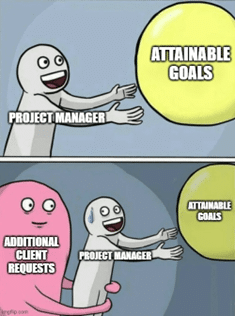Time to market can make or break a product’s success. Delays in product launches block revenue and cause a cashflow problem for the business. You have customers waiting. And you have competition arising from “Me Too” products. This is especially true in the world of embedded systems.
If your electronics and embedded product development is slow, identify the cause from the following.
Table of Content
Toggle1. You Didn’t Have a Detailed Plan
Do you have a strong team of developers but still experience delays in product launches? Then have a look at your planning. Without a clear roadmap and well-defined scope, development teams go off track. Vague requirements mean more revisions and changes. This causes wasted time and effort.
- Did you create a project plan?
- Were your specifications detailed enough?
- Did you include all developers in the planning phase?

Image source: imgflip
2. You have Resource Constraints
Limited resources slow down product development. A shortage of skilled engineers is a typical constraint. Other common constraints are lack of training, equipment, and funding.
The skill level of your developers will affect your product launch. All developers are not the same. Good developers can create elegant solutions in a short time, while an average developer can add delays (by introducing bugs).
- Is your team skilled?
- Is it overloaded?
- Does it have the necessary tools?
Identify the reason and consider investing in additional resources or outsourcing aspects of your project where your team is less experienced.
3. You Face Scope Creep
Scope creep happens when the project’s features extend beyond the original plan. This results in additional work that delays your launch.
Was your initial plan detailed with defined work boundaries? If not, you are figuring out what to develop on the go. This is fine, but you cannot expect the work to finish soon until you start saying no to additional features.
Did you have clear objectives but the customers or the team kept adding more features? Then you need to introduce a strict change-control process.
 Image source: imgflip
Image source: imgflip
4. You keep Iterating the Hardware
Fewer PCB iterations = Faster product launch
Each PCB iteration takes around 6-8 weeks. Add to that any development delays.
This is a big problem and requires a blog of its own. In short, this happens when
- Your schematic and PCB design have stupid errors (because you don’t have design reviews)
- Your developers lack the experience to get it right in the first iteration (and they didn’t consult with experts)
- You are adding more features (read the above scope-creep section again)
Hire developers who read the datasheets well and pay attention to detail. They are well-suited for hardware design. Or cultivate this culture. This is where hardware design starkly differs from software development. The cost of a mistake during development in software is low; You find the bug, you fix it, and you push the code. In case of a hardware mistake, you lose an iteration. Therefore the quote “measure twice, cut once” is a good device for hardware developers.
Simulating your circuit also helps identify problems before the hardware is manufactured.

5. Your Developers Don’t Test Individual Modules
Before the firmware developers start working on the hardware, did someone from the hardware team test the hardware in detail? Software developers could bang their heads for days before finding out that the fault was in the hardware, not their code.
Your team lost days, by saving a few hours from testing.
The same goes for testing the final software and hardware. Don’t skip unit testing. Unit testing reduces the cost of bugs.
 Source: Dilbert Comic
Source: Dilbert Comic
6. You Face Regulatory and Compliance Requirements
Launching hardware products involves navigating complex regulatory and compliance standards. Be it CE, UL, FCC, or another regulatory body. It is crucial to ensure that your product meets these requirements. And it is time-consuming and challenging to stay up to date with evolving standards.
- Identify the certifications you need.
- Bring in experts well-versed in regulatory and compliance issues.
Involve experts at an early stage. This will help in preventing redesigns.
7. You Have to Onboard New Developers Often
Delays in long projects are often made worse because you need handovers between developers. Project handover from one developer to the next requires significant time. That can be reduced by having recorded requirement collection sessions and transfer of knowledge meetings. Remember, developer time is the biggest constraint companies face these days in their development plans.
If you often face additional delays due to handovers and onboarding, you probably need to have a deeper look into your company culture. Why aren’t the developers staying until the project’s completion?
8. You Ignored the Importance of Constant Communication
Poor communication results in misunderstandings, misaligned expectations, and, ultimately, project delays. When you and your customers are not aligned, you’ll do wasted work and have scope creep. When managers and developers are not aligned, developers duplicate or overlook the tasks. And you can’t blame them.
- Does your team have weekly project sync or sprint meetings?
- Does everyone have visibility into all the tasks?
- Is the manager sharing and reminding everyone of the project plan regularly?
9. TLDR; Takeaway
To reduce time to market,
- Have a skilled team on board.
- Plan well for low waste of development effort.
- Identify and prioritize the essential features. Don’t aim for everything.
- Make sure everyone sticks to the above 3.
Being clever about what you work on gives you better results than working harder.


